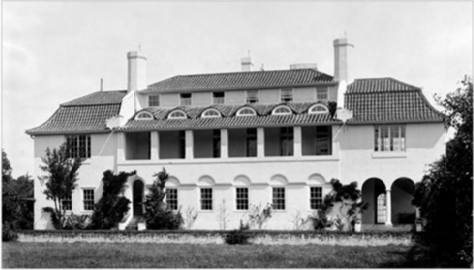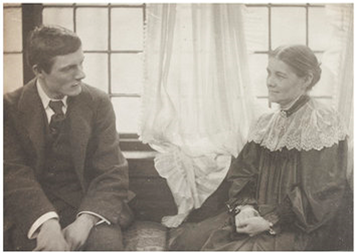Sophie Weisse And Her Favourite Pupil
As part of our current exhibition, Educating Egham: Schooling in Egham, Egham Hythe, Englefield Green, Thorpe & Virginia Water, museum volunteer and researcher, Margaret Stewart investigates some interesting characters and their educational connections to the area.
In 1892 Sophie Weisse (1851-1945), a music teacher from Eton, purchased Bendemere House in London Road, Englefield Green (built in 1871) and turned it into a girls’ school under the name ‘Northlands’. Described by her contemporary, Edward Speyer, as “a woman of strong character and great intelligence” [i] she was the daughter of German immigrants who had settled in Edinburgh in 1848. Her father, Traugott Heinrich Weisse, was a German teacher who wrote a much respected book of German grammar and her mother, Lithuanian pianist Sophie Marquidorff, gave chamber concerts. Northlands became fashionable as a school of general education for young ladies, with a strong emphasis on music.
However her most distinguished pupil was not a Northlands student at all. In 1880, while in Eton, she took as a piano pupil the five-year old Donald Tovey, the son of an Assistant Master at Eton College (later rector of St Mary’s, Worplesdon). She persuaded his parents not to send Donald to Eton but educated him herself, until he won a place at Balliol College Oxford.
When he returned from Oxford to teach at Northlands she built a large concert-room in which frequent performances of music and lectures on other subjects were given. This included a series of chamber concerts to show off his talents as pianist and composer alongside other prominent artists including Joseph Joachim, Myra Hess and Pablo Casals. On several occasions London orchestras were engaged so that Tovey might gain experience as a conductor. As a result, Northlands became a centre of intellectual and artistic activity.


Image © The Museum of Music History. [iv]
To Joseph Joachim
Belov’d of all to whom that Muse is dear
Who hid her spirit of rapture from the Greek,
Whereby our art excelleth the antique,
Perfecting formal beauty to the ear;
Thou that hast been in England many a year
The interpreter who left us nought to seek,
Making Beethoven’s inmost passion speak,
Bringing the soul of great Sebastian near.
Their music liveth ever, and ’tis just
That thou, good Joachim, so high thy skill,
Rank (as thou shalt upon the heavenly hill)
Laurel’d with them, for thy ennobling trust
Remember’d when thy loving hand is still
And every ear that heard thee stopt with dust.Robert Bridges, May 2, 1904.[v]
Tovey built up his reputation not only by performing but also by writing articles and reviews for The Times Literary Supplement and many of the music articles for the 1911 Encyclopædia Britannica. By 1911 Tovey was finding his relationship with Miss Weisse suffocating and he made attempts to break free.[vi] Hoping to keep him close at hand, in 1911 Miss Weisse commissioned Harry Stuart Goodhart-Rendel – a music graduate from Trinity College Cambridge who had been a student of Tovey at Northlands in 1904 but was now an architect – to build a house for Donald Tovey’s use. This was the Pantiles (now Forest Court) in Simon’s Walk which was built following the style of buildings designed by Sir John Soane.

An article in Country Life in 1916[vii] described it as “an additional residence in connection with a large school. “ But Donald Tovey was not to stay there for long. In 1914, despite his mentor’s protests, Tovey applied for and was appointed Reid Professor of Music at the University of Edinburgh.
He still could not break entirely free of her influence and in 1925 she tried to oppose his marriage to Clara Wallace, a former Northlands student. However he never forgot her role in building up his career and in 1936 he presented Sophie Weisse for the honorary degree of Doctor of Music at the University of Edinburgh in recognition of her services to music.
Donald Tovey died in Edinburgh in 1940. In his memory Miss Weisse gave No. 18 Buccleuch Place to the university, part of which became study-rooms for students of music; in accordance with her wishes they were called ‘The Tovey Memorial Rooms’.
Sophie Weisse retired and closed her school in 1919 but she continued to live in Englefield Green until her death in 1945 and she is buried in Christchurch cemetery. She bequeathed to Edinburgh University portraits of Sir Donald Tovey and herself by Philip Alexius De Laszlo[viii] and £750 for the foundation of the Tovey Memorial Prize for annual award to the undergraduate in the Faculty of Music who shows the greatest promise in composition or in instrumental performance.
In 1922 the school was purchased by the Misses Isobel and Gwendoline Rhys who reopened it as a private school for girls aged 6-14 under the name St David’s. The school finally closed in 1966 when the lease expired. The building was damaged by fire in 1970 and later demolished.
Margaret C Stewart
[i] Eshbach, Robert (2016) A Victorian Musician. https://josephjoachim.com/2016/01/23/a-victorian-musician/#_ednref12 [Accessed 15 March 2018]
[ii] Photograph by Frederick Hollyer © Victoria and Albert Museum, London.
[iii] Shore, Peter R (2008) Sir Donald Francis Tovey (1875–1940). http://www.donaldtovey.com/?page_id=96 [Accessed 15 March 2018]
[iv] http://www.momh.org.uk/exhibitions-detail-photo.php?cat_id=5&prod_id=266&type=sub&id=424 [Accessed 22 March 2018]
[v] Eshbach, Robert ibid.
[vi] Kelly, F.S. (2004) Race Against Time, the diaries of F.S. Kelly. National Library of Australia. https://books.google.co.uk/books?id=ErX1-eHqmVUC&pg=PT41&lpg=PT41&dq=northlands+school+englefield+green&source=bl&ots=ghDvm_Dimw&sig=rqQ5R45X-tg1JiHWeGrHjRiVpNc&hl=en&sa=X&ved=0ahUKEwiQw8ChmqjZAhVsCMAKHfykC3EQ6AEIcjAH#v=snippet&q=weisse&f=false [Accessed 22 March 2018]
[vii] Weaver, Lawrence (1916) The Lesser Country Houses of Today: The New House, Northlands, Egham. Country Life 18 November 1916.
[viii] De Laszlo, Philip Alexius (1912) Sophie Weisse. Portrait in the University of Edinburgh Art Collection. https://collections.ed.ac.uk/art/record/19682 [Accessed 22 March 2018]

